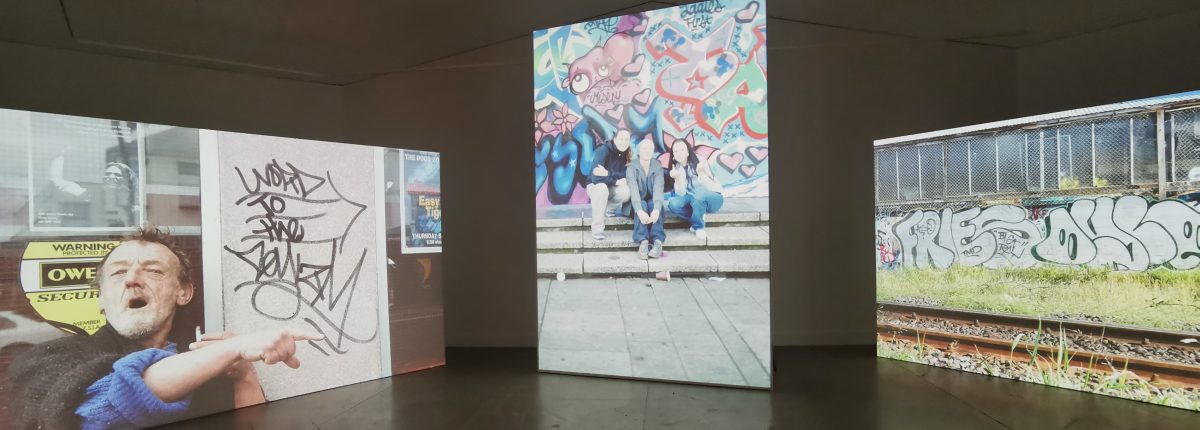“The rise of TMD as a creative collective has its origins in Auckland’s mid to late 90’s graffiti scene. The post-recessionary environment after the 1987 stock market crash was the perfect incubator for a thriving and vibrant Hip-Hop scene with a uniquely pacific slant. From the decrepit rail infrastructure to the abandoned buildings and vacant lots – the city provided an abundance of grey area where these young people could forge lifelong bonds, while cementing their sense of identity. With humble beginnings from this crew emerged its fair share of unsung and underground heroes as well as many of Aotearoa’s first global stars in the graffiti and large scale street art arena.” – ASKEW ONE (from The Dowse website)
There is no larger shadow in Aotearoa graffiti and street art history than Auckland’s TMD crew. While not the oldest graffiti crew in New Zealand, founded in 1997 by Phat1 and Adict, TMD has undeniably made an indelible mark on graffiti and street art culture both here and overseas. The collective has grown both in number (with over 35 past and present members, including international representatives from Australia and Germany, such as Vans the Omega, Sofles and WOW123) and scope, with its members ranging from recreational graffiti writers to professional artists, occupying streets, studios, galleries and beyond. Both collectively and individually the members of TMD have gained prominence here and overseas, from Phat1 and Diva’s (Charles and Janine Williams) Bird Gang mural work, telling stories of place through the symbolism of native birds, to Misery‘s instantly recognisable kitschy doe-eyed characters and Berst‘s dynamic letterforms and documentation of graffiti culture, where his online videos have an audience of tens of thousands.
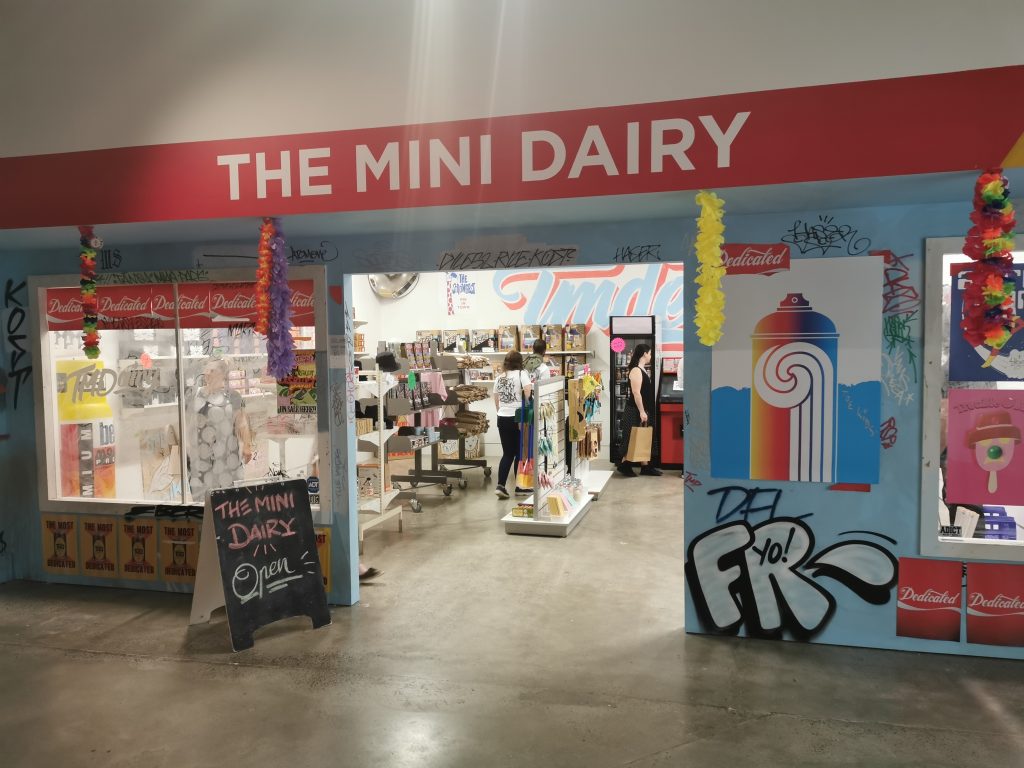
In recent years, urban art has gained more widespread attention, publicly through the rise of contemporary muralism and its ability to infiltrate our daily experiences, but also institutionally, with the likes of Rise at the Canterbury Museum (2013) and Paradox at the Tauranga Art Gallery (2016). The staging of TMD: An Aotearoa Graffiti Story at Lower Hutt’s The Dowse Art Gallery (who themselves have a history of urban art-related exhibitions dating back to the turn of the Milliennium), running from late March until June, is a welcome development. Rather than attempting to present a more generic survey or a one person show, the exhibition considers the broader cultural movement of graffiti within the tighter focus of the TMD crew while still spanning styles and historical narratives; contextualising both the roots of the TMD crew within the setting of mid-90s and early 2000s Auckland, and their current exploits, successfully packaging the complexities and trajectories of contemporary urban art and artists who have sprung forth from these rebellious beginnings, no longer held to any defined expectations.
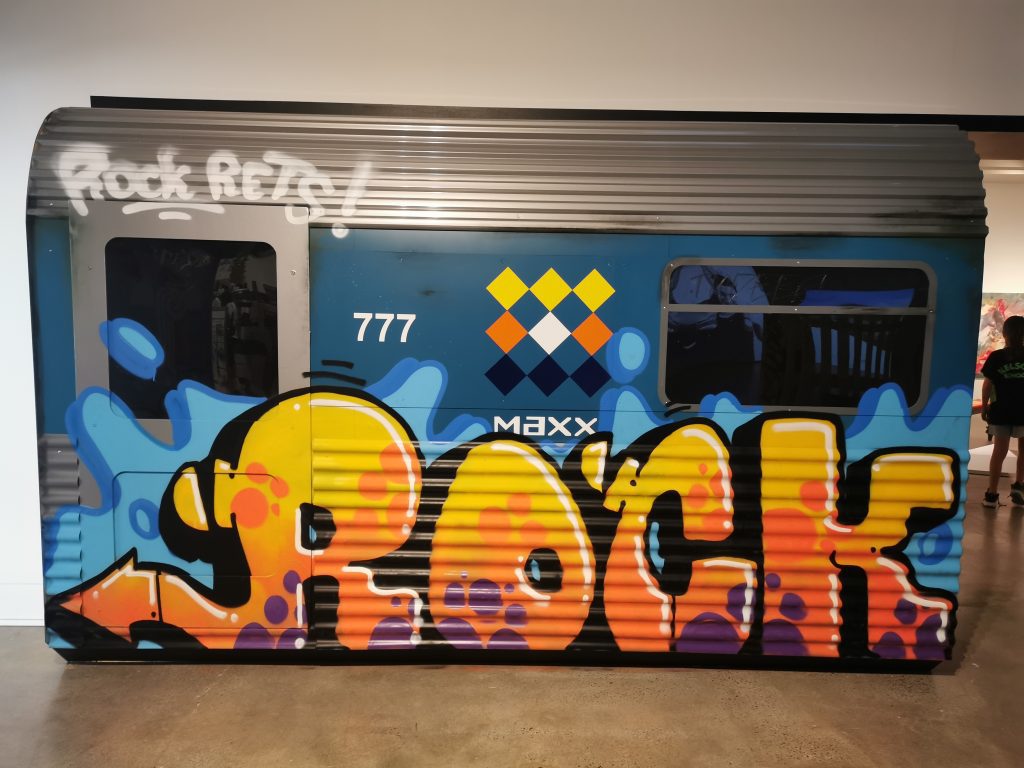
The exhibition, curated by Dowse director Karl Chitham with Christchurch-raised TMD member Pest5/Johnny 4Higher, is split between two distinct zones, an immersive installation space, featuring formative and contextual commentaries, and a more traditional white-walled gallery presentation that highlights the current work of crew members, spanning painting, sculpture, photography and more. This format allows the viewer to consider the significant journey undertaken by the crew, from an idea to unite disparate graffiti writers into a collective of diverse creatives, placing them within the wider narrative of New Zealand art while acknowledging the significance of graffiti culture to generations of young New Zealand creatives.
On entering the exhibition, visitors are greeted by a writers bench and a set of painted train carriages, with an echo of recorded discussions just audible. Smaller tags on the bench play off against the larger and more bombastic train pieces. The track setting highlights the centrality of train painting in graffiti culture not just locally, but internationally, although with a specific Aotearoa profile. Behind the bench is another slice of Kiwiana, an iconic corner dairy, a bastion of New Zealand childhoods across generations. The fabricated dairy, named the ‘The Mini Dairy’ (TMD), utilises all the nostalgic riffs, from the Tip Top-inspired signage to dollar mixtures (the lollies replaced with aerosol nozzles), neon star price points and an arcade video game machine (supposedly out of order). A cynical eye might point out that the dairy is primarily the exhibition shop, providing the opportunity to peddle merchandise, but it also has several conceptual references as an installation in its own right. Dairies served as a location youngsters not only congregated around, but also as a community hub that would often provide the opportunity for legal or commissioned murals on their walls prior to larger commercial projects becoming a reality. Furthermore, the dairy exemplifies how the creation of commercial goods has been embraced by urban artists, from clothing to vinyl toys, a trajectory that might make the more elitist fine art world shudder (think of the blowback against Kaws by art commentators), but is a reality for many to make an artistic career possible and their art accessible to an audience perhaps less likely to frequent an art gallery.
Across an imaginary road is a grungy flat, based on a former residence where crew members congregated. The sparse room provides historical references in analogue form with tags and drawings on the walls (including a roll call in the classic New Zealand Straights lettering style) and scattered photo albums, event posters and blackbooks, but also digitally – with videos from TMD member Berst’s Real Time web series playing on the boxy 90s TV, and an old PC for surfing websites such as ArtCrimes, an influential forum for the graffiti world and an inspiration to many TMD members. The worn surroundings, devoid of luxury, highlight the drive to make things from nothing and the dominant influence of graffiti on the lives of these young creatives and the evolution of the relationship between graffiti and the internet.
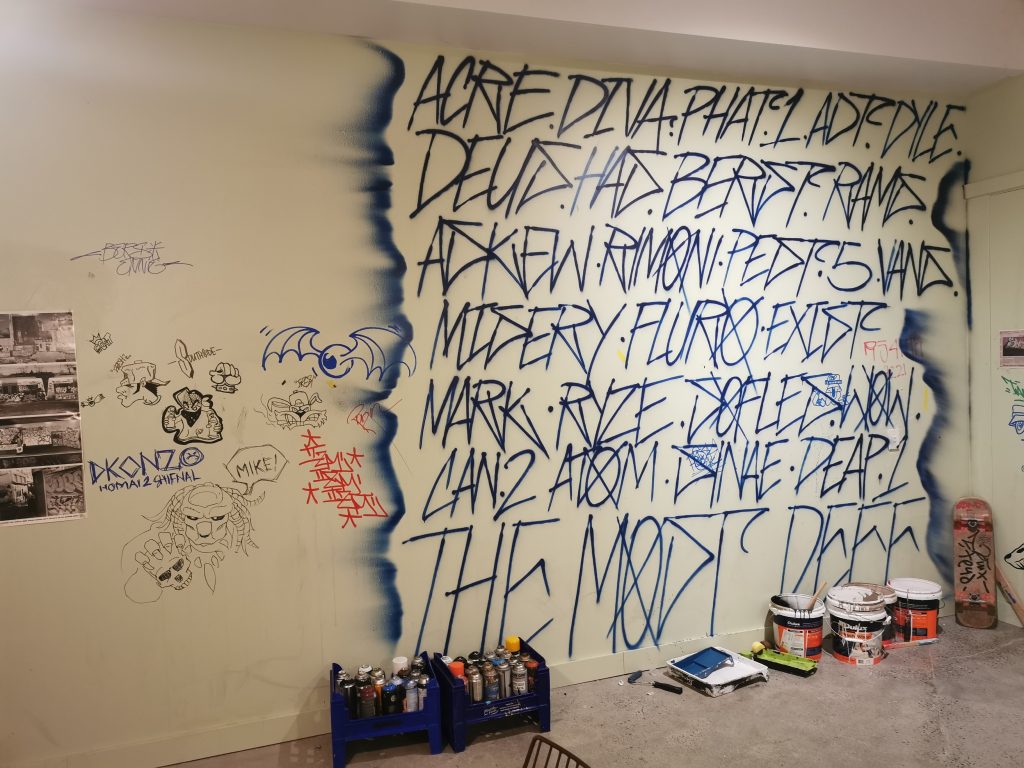
Tucked around the corner, a rotating selection of photographs (photographers and crew members Rimoni and OneDeap have been key documentarians of this history) adds a personal face, members depicted painting, posing, and playing, projected oversized on the gallery walls, imbuing candid moments with significance. Either side, collaborative wall paintings highlight the traditional graffiti approaches and styles of crew members, referencing the common form of crew productions, as well as providing a bridge towards the gallery space and the work artists have developed over ensuing years. These immersive spaces are informative (notably the stories are not given to you in wall text, they become part of the environmental detail – wafting audio, static encoded video, interactive elements and references in the most traditional urban forms – tags and wall writing, a fit for graffiti’s own historical recording which has for a long time been largely folkloric), providing important context for viewers before they cross the threshold into the white cube space.
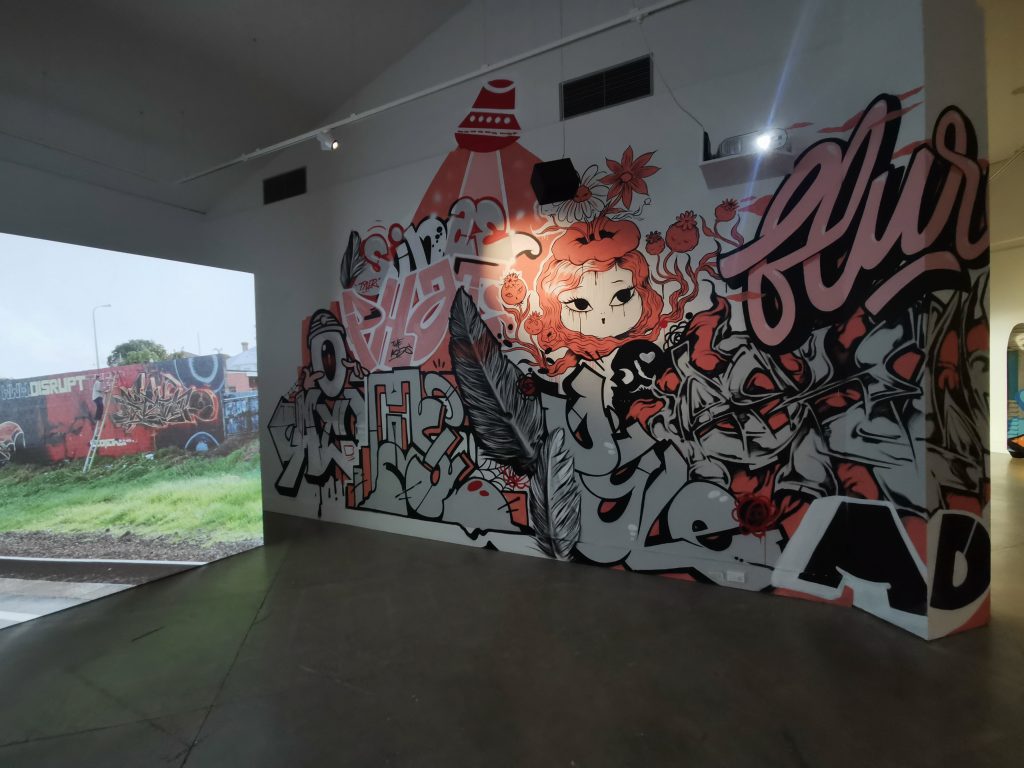
The ‘Post-Graffiti’ gallery space features works that span the spectrum of practice. Book-ended by impressive works at either end; Benjamin Work‘s tapa cloth-inspired banner unfurled from wall to floor, drawing on the iconography of his Tongan heritage and Lady Diva’s subtle flag-like geometric abstractions on wooden panels, suggesting references to carving and weaving that perhaps raise ideas of colonialism and imperialism, the spaces in between are filled with varied works. Askew‘s glimmering digital-influenced painterly abstractions that draw on the spectre of shifting human presence in our urban environments contrast with Deus’ (Elliot Francis Stewart) intricately illustrated coffee table, drawing the viewer closer to inspect the stunning graphic details on a mundane domestic object. Gary Silipa‘s unsettling and powerful installation filled with painted tyres, yellow chain links, tarpaulin and painted iconography sits near the still reverence of Berst’s pillar-like sculptural letter forms, light emanating from inside to give a celestial glow to an apparently devotional monument to graffiti. Other works highlight a raft of concerns, from social issues, cultural and national identity and self-reflection, to moments of everyday life, process-driven focus, riffs on the traditions and evolutions of graffiti writing and the urban environment and striking abstract ruminations. The diverse spectrum of themes, as well as styles, materials and approaches, suggests the personal creative journey of each contributor, and yet, there is an undefinable connection as well, the shared experiences and the original creative impetus of graffiti hang in the air, unifying the collection without requiring explicit threads.
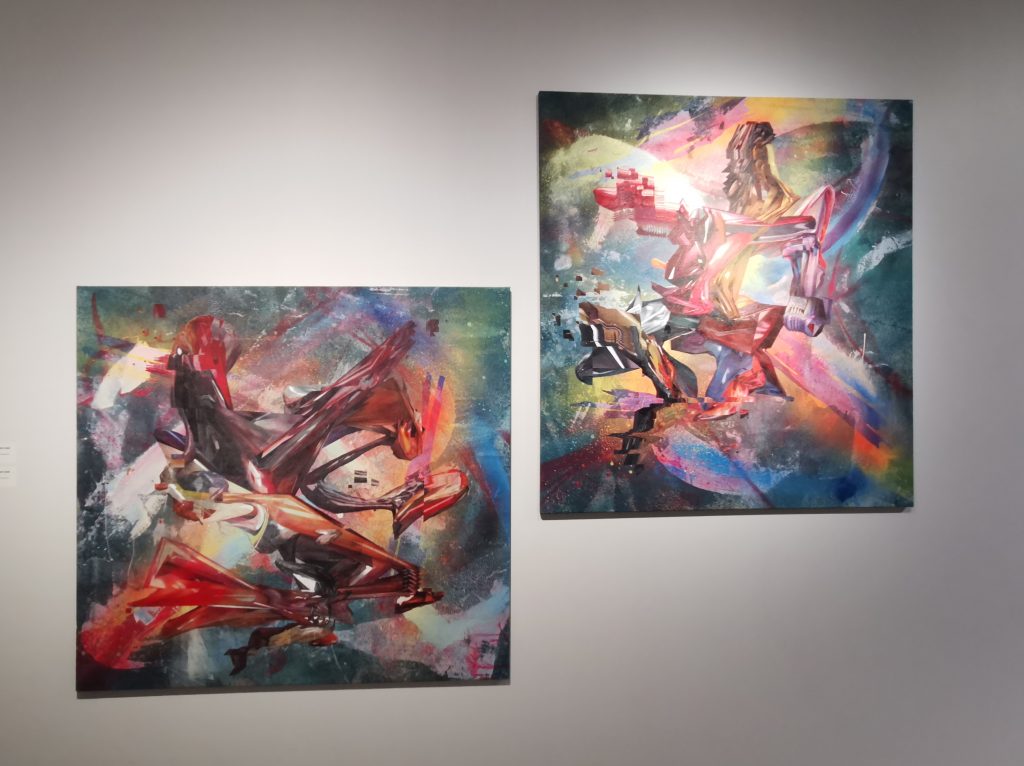
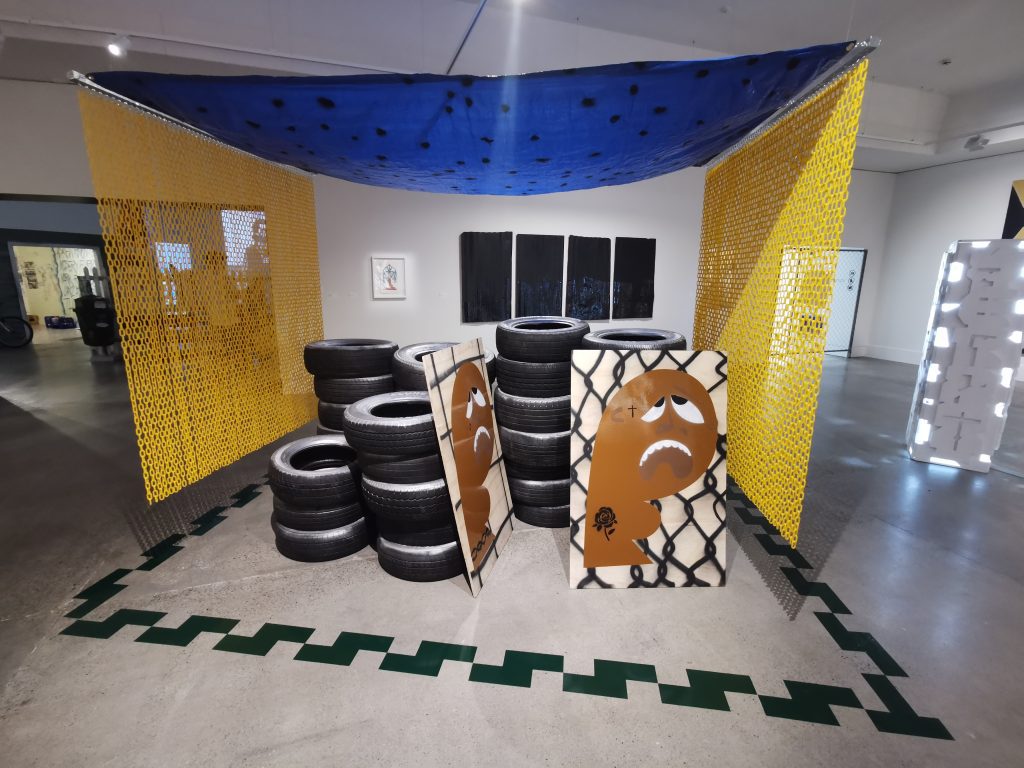
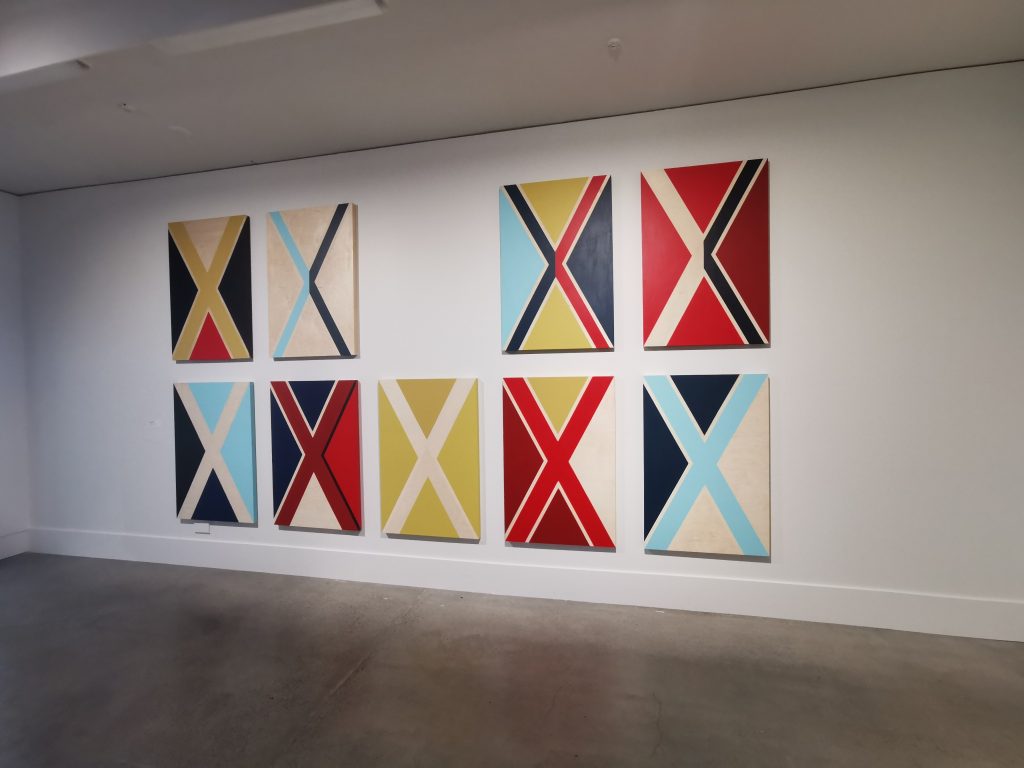
While the format may mean some viewers relate with specific elements more than others, the narrative of TMD: An Aotearoa Graffiti Story could not be told in one presentation style alone. As it was probably to be expected, the exhibition drew some criticism for the presence of tagging, but to pick such a quarrel is to miss the bigger picture. Graffiti writing brought these young people together and is part of their creative pathway. The presence of graffiti is a central and necessary part of the story, informing the narrative both socially and formally. TMD: An Aotearoa Graffiti Story revels in the celebration of collectivism and its empowering potential for individual members. As a representation of urban art’s roots and future pathways, TMD: An Aotearoa Graffiti Story is surprisingly focussed. Rather than a pervasive survey of graffiti and street art in New Zealand, TMD: An Aotearoa Graffiti Story, nodding to those that came before and winking to the future, is grounded in the environments and relationships of the artists of TMD, a camaraderie that emanates throughout the history of this crew and the show itself.
TMD: An Aotearoa Graffiti Story at The Dowse Art Gallery runs until June 2021.

